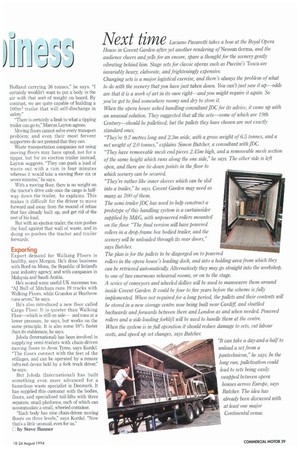r I rd Next time Luciano Pavarotti takes a bow
Page 41

If you've noticed an error in this article please click here to report it so we can fix it.
at the Royal Opera house in Covent Garden after yet another rendering of Nessun dorma, and the audience cheers and yells for an encore, spare a thought for the scenery gently vibrating behind him. Stage sets for classic operas such as Puccini 's Tosca are
invariably heavy, elaborate, and frighteningly expensive.
Changing sets is a major logistical exercise, and there's always the problem of what to do with the scenery that you have just taken down. You can't just saw it up—odds are that it is a work of art in its own right—and you might require it again. So you've got to find somewhere roomy and dry to store it.
When the opera house asked handling consultant JDC for its advice, it came up with an unusual solution. They suggested that all the sets—some of which are 19th Century—should be palletised; but the pallets they have chosen are not exactly standard ones.
"They're 9.7 metres long and 2.3m wide, with a gross weight of 6.5 tonnes, and a net weight of 2.0 tonnes," explains Simon Butcher, a consultant with JDC "They have rernoveable mesh end-pieces 245m high, and a removeabk mesh section of the same height which runs along the one side," he says. The other side is kit open, and there are tie-down points in the floor to which scenery can he secured.
"They're rather like inner sleeves which can be slid into a trailer," he says. Covent Garden may need as many as 700 of them.
The semi-trailer JDC has used to help construct a prototype of this handling system is a curtainsider supplied by M&G, with unpowered rollers mounted on the floor "The final version will have powered rollers in a drop-frame box bodied trailer, and the scenery will be unloaded through its rear doors," says Butcher The plan is for the pallets to be disgorged on to powered rollers in the opera house's loading dock, and into a holding area from which they can be retrieved automatically. Alternatively they may go straight into the workshop, to one of two enormous rehearsal rooms, or on to the stage A series of conveyors and wheeled dollies will be used to manoeuvre them around inside Covent Garden. It could be four to five years before the scheme is fully implemented. When not required for a long period, the pallets and their contents will be stored in a new storage centre now being built near Cardiff, and shuttled backwards and forwards between there and London as and when needed Powered rollers and a side-loading forklift will be used to handle them at the centre When the system is in full operation it should reduce damage to sets, cut labour costs, and speed up set changes, says Butcher
"It can take a day-and-a-half to unload a set from a pantechnicon," he says. In the long run, palletisation could lead to sets being easily swapped between opera houses across Europe, says Butcher The idea has already been discussed with at least one major Continental venue.
























































































